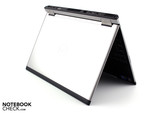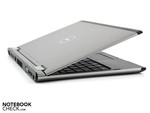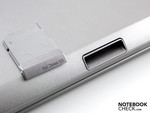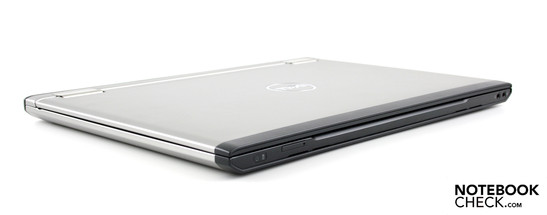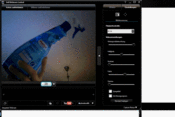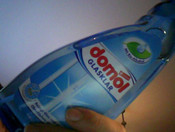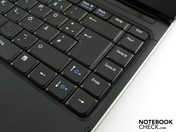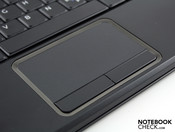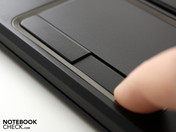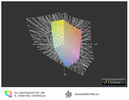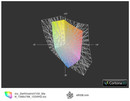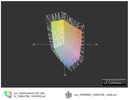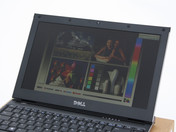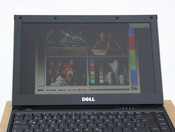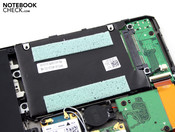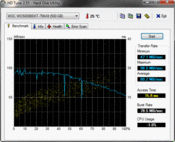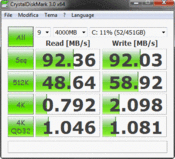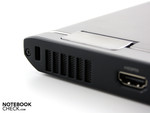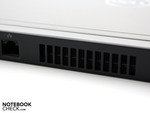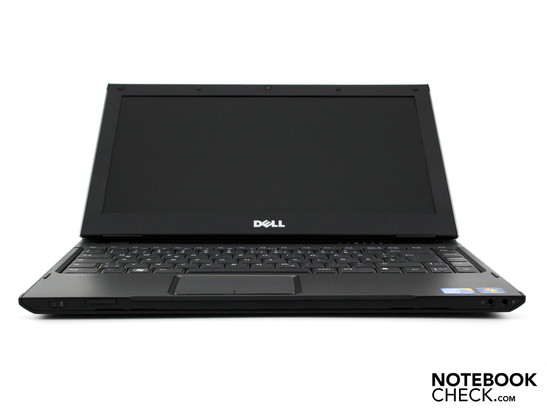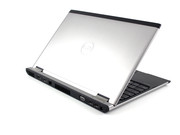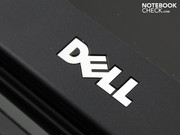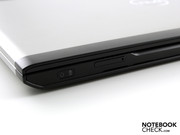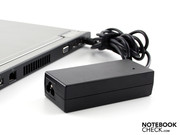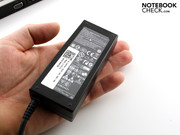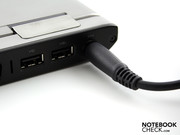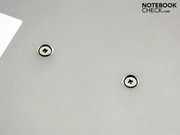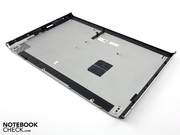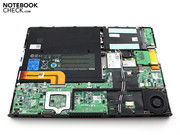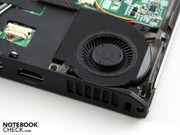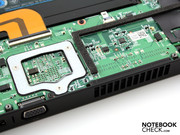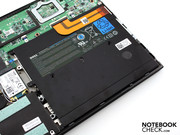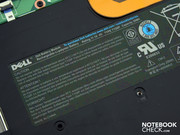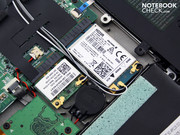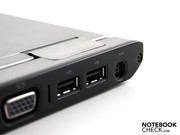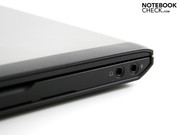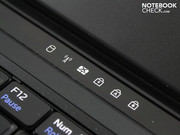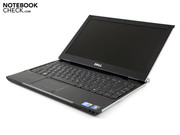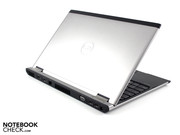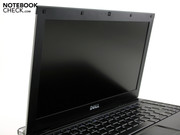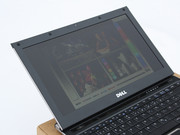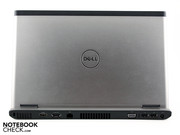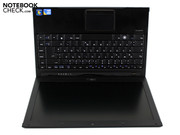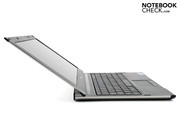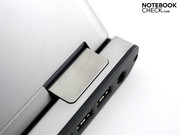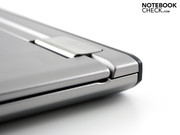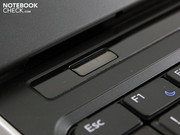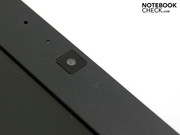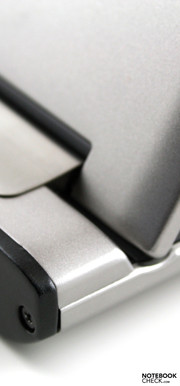Review Dell Vostro V130 470UM Subnotebook

It's alive! The Vostro, it's alive again! That's right, folks. Dell has released a new business subnotebook under its Vostro line! It's been almost a year since the Vostro V13 with a Penryn Low-Voltage (processor codename) jumped out onto the market in a compact 13.3" form. The Penryn era was already, however, coming to an end, soon to be replaced by Intel's new Arrandale CPUs.
Now, embarking upon a new year, the Dell folks based out of Texas present to us a big update to their compact Vostro subnotebook. This time the V130 13.3" subnotebook comes with an up-to-date chipset (Intel HM57) and an Arrandale processor (Core i5 470UM) and an improved cooling system. Aside from that, the variety of ports has been increased as well as shifted around.
Read on to see whether this upgrade made a difference. The V13 test model from the beginning of 2010 could only manage a battery life of four hours (WiFi test) even with its low-voltage processor. Can the V130 outdo its predecessor and hold out longer away from the power outlet?
This review of the Dell Vostro V130 470UM replaces the short test of the pre-production model of the V130 from the 1st of December 2010. This time our test model is the same that's available to you. The measurements here concerning battery life, performance, design, etc. describe the actual model currently on the shelves of many stores.
Case
Dell has taken on a whole new design paradigm in 2010, not just for Vostros but also XPS 15"/17" and Inspiron models. The screen hinges are no longer located at the very back of the base unit or hanging off it as in the case of "sunken hinges". No, Dell has improved upon this design by placing the display hinges a centimeter to the front of the base unit's back edge. This not only helps with production of the laptops but also facilitates use of the laptop in several ways.
Especially small and thin notebooks, like the Vostro V130, profit from the base unit jutting out behind the screen hinges. For one, ports can now be placed at the back without being obstructed by the screen tilting back. This means less cables coming from the sides and cluttering up desk space. The sturdiness of the construction has improved dramatically, as the V130 goes to show.
The sturdy case is noteworthy (only 19.7 mm high when closed). The metal hinges hold the screen upright and tight and only does the cover wobble when shaken violently. The maximum angle for opening the cover is hardly affected by the back edge of the base unit, coming to 140º. "Normal" notebooks with typical sunken hinges open up to a maximum of 130º to 140º. What's particularly praiseworthy is the rubber bumper in the screen hinges that allows for the display cover to come to a stiff but cushioned halt when opened as far as it can go.
The completely aluminum case consists of a removable base plate, a top cover (surrounding the keyboard) and the display lid. The only plastic part is what holds the mainbord, hard drive, battery and fan together on the inside. The total weight of 1.638 kg is just about average for subnotebooks. Competitors like Apple's MacBook Air (1.33 kg) or the Adamo XPS (1.43 kg) are noticeably lighter. You wouldn't expect the Vostro to weigh so much looking at its compact case, but it adds to the quality and sturdiness of the case.
Particularly noteworthy is the how the display lid closes quickly. One thumb is enough to open it up, but two magnets located on either side of the display frame pull it down toward the base unit to shut firmly. However, this does not prevent the display lid from dropping open when the laptop is held upside-down by the base unit.
Finally, the last part of the case's sturdy design is the non-removable lithium-ion battery with a capacity of 30 watt-hours (located underneath the base plate). Nothing has been changed in terms of the placement of the battery or its capacity compared our test model's predecessor, the V13.
Connectivity
What's really exciting is the placement of the ports. We usually end up criticizing most notebooks for the lack of ports at the back, which otherwise reduce the number of cables flowing forth from either side of the laptop and cluttering up workspace. Luckily, the V130, like its predecessor, has most ports at the back. The strip of sleek aluminum at the front is broken up only by a card reader (SD/MMC/MS/MS Pro/xD).
Compared to its predecessor, the V13, the back of the new V130 has been completely revamped. Now, in addition to the exhaust vent (middle), there's also an air intake vent (far left). This means the eSATA, VGA, USB and Ethernet ports had to be shifted over. Since the V13 only had one USB 2.0 port, Dell's made things a bit easier by adding two more USB ports and an HDMI port. One of the three USB ports is a USB/eSATA combo port.
Both audio ports have been conveniently placed at the front. The ExpressCard34 slot has, however, been removed (compare to Vostro V13). The cooling system has taken on a completely new shape and thereby forced some structural reductions. At the front on the left you won't notice a port cover marked with a black dot. In the V130 model with an HDSPA module, a SIM card could be inserted in this spot. So that the SIM card could not be taken out accidentally or by an angry coworker, you need something like the tip of a paper clip to pull out the SIM card tray. Removing a SIM card while its in use may damage it!
Internet and Bluetooth
This 13.3" notebook is equipped with the most current data transfer technology like Gigabit Ethernet (Realtek) and Draft-n-WiFi (Dell Wireless 1702). The high Bluetooth v3.0+ standard is included. For an additional price, the V130 comes with a Dell 5540 EM820U HSPA modem for mobile web access. You can see this in the last picture in the photo gallery at the right (this was included in V130 pre-production model we reviewed earlier). The high-resolution webcam (1,600 x 1,200 pixels) comes as a surprise. So that photos don't come out too fuzzy, you need a very good light source (like the sun).
Security
Business features like the Trusted Platform Module, fingerprint scanner (used in Vostro 3300, 13.3") or a docking port are foreign to the V130. The laptop can, however, be secured with a proper cable attached to the Kensington Lock slot to prevent theft. For much more important protection from data theft, the software packet Worry Free Business Security Services from Trendmicro is available. A license costs 60 Euro. We can't quite evaluate the quality of this software, however. The software is intended for small businesses without an IT department and should protect you from viruses, hackers, spam, spyware, phishing and data theft. Via a web-based console, you can fully control the V130 of a coworker. The Remote Manager allows IT-technicians to remotely service the laptop.
Accessories
At the lowest price, the notebook comes with Office Starter, diagnostics programs, drivers, Worry-Free Business Security Services as well as webcam software. What's nice is that all the previously named software as well as Windows 7 Home Premium 64 Bit come in the form of CDs and DVDs. That is, the user doesn't have to burn his own recovery CDs, which seems to be the practice with just about all other manufacturers today.
Warranty
The standard warranty lasts 12 months after the date of shipment. At an additional cost, Dell offers extensions such as the 3-year Pro Support warranty with send-in next-day service (83 Euro).
Input Devices
Keyboard
The keys allow for fluid typing and are all perfectly sturdy. Compared to the pre-production model, there've been some improvements made. The generous 16mm-wide keys (19mm counting space between keys) take up the entire usable width of the base unit. There's even space at the right for the page up/down as well as home and end keys. The large enter and backspace keys are very convenient. The arrow keys would have ideally been separated from the rest. But due to the keys' standard size, typos don't occur that often even without the separation.
The moderate depression depth of the keys is accompanied by the clear keystroke pressure point, (the keystroke has to be fairly firm, however). This tactile indication of whether you've hit the key is quite convenient for 10-finger typers but may take some getting used to.
Touchpad
The touchpad plays its part splendidly. This multi-touch pad (Synaptics) is fairly large and has soft buttons that press in quite deep all surrounded by a smooth border. The soft keystroke for the touchpad buttons produces no sound and allows for quick, comfortable clicking. For those who prefer scroll bars, a vertical and horizontal scroll bar are located at the right and bottom of the touchpad respectively. These, however, must first be activated through the Dell touchpad software. This software replaces the sometimes hard-to-understand Synaptics tool.
Display
Other than it being a non-reflective screen, the Vostro V130 is fitted with a typical consumer display. It's labeled simply as 133WH2 without any indication of the manufacturer (probably LG Philips). There are no customization options available at the time of purchase.
The 1,366x768 pixel, HD-ready screen has an aspect ratio of 16:9. The classic 4:3 ratio would have been more convenient for business (tables, documents, databases, greater height). However, in the name of mass production, the consumer widescreen display has made itself the standard just about everywhere. The weak contrast ratio of 201:1 comes as no surprise, as it's typical for office notebooks. The colors appear watered down as a result.
The small color space is to be expected considering the low contrast ratio. The V130 can't manage to cover any of the four color spaces depicted below, not even the very narrow color spectrum of the HP ProBook 6555b (t), which can't even cover sRGB. The V130 is depicted by the colored region in each image below.
| |||||||||||||||||||||||||
Brightness Distribution: 83 %
Center on Battery: 192 cd/m²
Contrast: 144:1 (Black: 1.51 cd/m²)37.18% AdobeRGB 1998 (Argyll 2.2.0 3D)
53.4% sRGB (Argyll 2.2.0 3D)
35.88% Display P3 (Argyll 2.2.0 3D)
The 13.3" LED screen shines as bright at 217 cd/m² (in the middle) with an average screen brightness of 201 cd/m². A value of 120 cd/m² is what's needed for comfortable indoor use, making this screen more than sufficient in this respect. The brightness distribution is fairly even at a good 82%. Darker and brighter regions are not noticeable when the screen is black.
The matte screen makes it possible to use the notebook outdoors during the day, at least when it's cloudy (see photos below). When using the notebook in direct sunlight outside, the display isn't quite bright enough. The maximum screen brightness of 201 cd/m² dims down on when on battery power to 192 cd/m². The V130 is not the best notebook to sit down with on the patio during the summer. To the Vostro's credit, we have to mention that very few business notebooks have screens that are more visible outdoors than that of the V130. The Vostro 3300 manages 183 cd/m², the expensive ThinkPad T410 (1,800 Euro) reaches 201 cd/m².
The narrow range of viewing angles is typical for consumer LCD screens. To the left or right of a direct viewing angle, colors appear distorted at as little as 45º. Print, however, remains readable for up to 80º. When tilting the screen back and forth, 10º away from a direct viewing angle is enough of the picture to become distorted, either in the form of screen contents darkening (bottom row of image) or starting to look like an overexposed photo (top row).
Performance
Dell has put in place a dual-core i5 470UM (32 nm Arrandale) processor in the V130. The base clock rate of 2 x 1.33 GHz and the TDP (thermal design power) of 18 watts (UM-model) make this a typical low-voltage CPU. The Turbo function can raise the clock rate to 1.86 GHz during single-core use. For multi-core applications, which are more relevant for office use, the Hyperthreading function is more exciting—which allows the CPU to simultaneous process four threads.
The V130 can alternatively be ordered with the following CPUs:
- Intel Celeron Processor ULV U3400 (2MB Cache, 1.06 GHz)
- Intel Core Processor ULV i3-380UM (3MB Cache, 1.33 GHz)
As with all i5 CPUs, the 470UM comes with a memory controller for DD3 RAM and an Intel HD graphics card. The AES New Instructions (useful for VMware) are not supported as would be the case with a 520UM. The 4GB of RAM are in place in the only available slot (not removable, max. 4 GB, PC3-10700 SDRAM). This chip is not accessible via the base plate. Dell's RAM standard is 2 GB, which means our test model must have been fitted with the 4GB that would come at an additional price to consumers.
The compact case has place for one 2.5" HDD, which in our case is one from Western Digital (WD5000BEKT, 500 GB, 7200 rpm). An SSD option is also available for the V130 (2.5", 128 GB).
We tested the performance of the i5 470UM using the Cinebench R10 Single-Core test (64 bit). This synthetic benchmark attests to the performance of the 470M (2x1.33 GHZ, 2,492 points) being on par with that of the Core i5 520UM (2x1.06GHz, 2,435 points). This score, however, doesn't reach the level of the i3 330M (2x2.13 GHz, 2,900 points) and is well below that of the i5 430M (2x2.26 GHz, 3,400 points). The 470UM and 520UM have the same Turbo clock rate of 1.86 GHz.
Compared to the CPU of its predecessor, the V13, our in-review Vostro has made some big strides. The old V13's Intel Core 2 Solo SU3500 (1x1.4 GHz), a weak CULV subnotebook processor managed only 1,468 points (32Bit). But the powerful Core 2 Duo LV processor of the same family, SL9600—6MB Cache, 2.13 GHz, placed in high-end subnotebooks,—even then reached a value of 2,726 points in the Cinebench R10 Single-Core test.
Processing with all available threads, that is, with Hyperthreading: 2 real cores + 2 virtual cores, goes to the advantage of the low-voltage Arrandale CPU. The processor earns 4,698 points in the Cinebench R10 Multi-Core (64bit) test—(520UM = 4.179; i3-330M = 6.600; i5-430M = 7.800). The Core 2 Duo SL9600 manages 4,815 points, placing it on par with our in-review i5 470UM. With Hyperthreading the 470UM (2 x 1.33 GHz) compensates for the SL9600's high clock rate (2 x 2.13 GHz).
| PCMark 05 Standard | 4329 points | |
| PCMark Vantage Result | 3813 points | |
Help | ||
The overall performance of this low-voltage system proves to be rather smooth. Multiple simultaneously running programs don't seem to faze the V130. PCMark Vantage tests the interplay of CPU, Intel HD graphics card, memory and the 7,200 rpm hard drive. The result is 3,813 points. This puts the subnotebook behind the Acer Aspire 1830T (520UM) but ahead of the Acer Travelmate 8172T (330UM). Compared to standard processors like in the Sony Vaio VPC-S13X9E (i3-370M, 13.3", 5,088 points) our 470UM-equipped Vostro doesn't even come close.
| 3DMark 2001SE Standard | 5768 points | |
| 3DMark 03 Standard | 2681 points | |
| 3DMark 05 Standard | 1963 points | |
| 3DMark 06 Standard Score | 1008 points | |
Help | ||
The 500 GB, 7,200 rpm hard drive in place in our V130 makes its presence known with a constant humming but has extremely fast access times in return. Tested with the more conservative HD Tune, the HDD is said to have a sequential read rate of 80.2 MB/s. Crystal Disk Mark 3.0 attests a slightly higher transfer rate of 92 MB/s (read/write). Typical 5,400 rpm HDDs reach 75 MB/s at the most (sequential read rate in Crystal Disk Mark).
Emissions
System Noise
Compared to the older V13, the cooling system has been completely revamped. It's called Intel Advanced Cooling Technology - Hyperbaric Cooling. This technology is supposed to keep system noise down while lowering the case temperature. Not only does the system have a snazzy name, it works pretty well too. In typical laptop cooling systems, the fan blows hot air away from the hardware and out of the case. The fan usually turns on once the processor reaches a certain temperature. The hot exhaust then travels through a copper heatpipe toward cooling fins, in which warm air is replaced by cool outside air.
Hyperbaric Cooling, on the other hand, sucks in cool outside air and channels it to the motherboard and over to the heat exchanger. In addition to finally replacing warm exhaust air, the outside air flowing through the inside of the case cools hardware components as it goes. Of course, this system also includes a copper heat pipe for directing exhaust away from the processor to the heat exchanger. The very back of the base unit behind the screen hinges is connected to the heat exchanger and allows for heat to flow out of the case even when the fan is off. That is, part of the metal case acts as a heat sink.
You'd think the advanced cooling system would keep the laptop quiet as a mouse. Then why does the V130 constantly produce an audible 32.6 dB(A) when idle? The fan is off, but the fast-spinning hard drive (7,200 rpm) produces a constant humming measuring 32.6 dB(A). This level of noise is not distracting but is the only ever-present noise coming from the Vostro. If you're looking for complete serenity in which you could hear a pin drop, you should definitely consider buying the SSD-equipped model or installing an SSD on your own.
Even under heavy use, the soft background noise barely grows. Using Prime95 (multi-core CPU test) and a 3D benchmark, we were able to raise the noise level to a maximum of 36.5 dB(A). Right after closing the 3D benchmark (Intel HD), the noise level drops significantly to a constant 33.9 dB(A). This is the highest noise level you should expect. It's noteworthy that the fan turns off within seconds of lowering the CPU load and only the humming of the hard drive can be heard (32.6 dB(A)).
Noise Level
| Idle |
| 32.6 / 32.6 / 32.5 dB(A) |
| HDD |
| 32.6 dB(A) |
| Load |
| 32.9 / 36.5 dB(A) |
 | ||
30 dB silent 40 dB(A) audible 50 dB(A) loud |
||
min: | ||
Temperature
During the processor stress test (Prime95 multi-core) the temperature of the Vostro V130 was, in the course of several hours, brought up to a maximum of 47.5ºC—however, this temperature was only present along the 1-cm-wide aluminum strip at the very back of the base unit behind the screen hinges. Besides that, all the sections across the top of the base unit remain a good deal under 30ºC. The 28.8-degree area directly in front of the hot aluminum strip really speaks to the effectiveness of the cooling system.
The base plate heats up to 36.3ºC next to the exhaust vent. The rest of the base plate remains between 26ºC and 35ºC. All in all, Dell has managed an exceptionally balanced cooling system. The fan is quiet and remains off most of the time so that warm exhaust air doesn't enter the surrounding area (except behind the screen hinges).
(+) The maximum temperature on the upper side is 29.7 °C / 85 F, compared to the average of 35.9 °C / 97 F, ranging from 21.4 to 59 °C for the class Subnotebook.
(+) The bottom heats up to a maximum of 36.3 °C / 97 F, compared to the average of 39.4 °C / 103 F
(+) In idle usage, the average temperature for the upper side is 22 °C / 72 F, compared to the device average of 30.7 °C / 87 F.
(+) The palmrests and touchpad are cooler than skin temperature with a maximum of 25.6 °C / 78.1 F and are therefore cool to the touch.
(+) The average temperature of the palmrest area of similar devices was 28.3 °C / 82.9 F (+2.7 °C / 4.8 F).
Speakers
Dell is forging a new path in laptop sound systems. We found no visible speaker opening anywhere on the case surface. We pinpointed the source to be the left half of the keyboard. the mono-sound produced is extremely loud and remains undistorted even at the highest volume. The sound is very mids-heavy, while the highs and bass are less noticeable. Nevertheless, we could feel the vibration of the bass on the left palm rest.
In short, the high volume is perfect for presentations and even music would be enjoyable with a few improvements (subwoofer, virtual sound). Along the front of the notebook is an audio jack via which you can hook up an external sound system. We tested this with two Yamaha speakers (YST-M20SDP). The sound produced was loud and undistorted (listening test, no measurements).
Battery Life
Dell has left the battery of the V130 unchanged compared to its predecessor, the V13 (6 cells, 30Wh, 2,700 mAh). The battery is not removable, making any kind of upgrade out of the question. Dell claims a battery life of 4 hours 21 minutes in a real office scenario.
Those hoping for at least the battery life of the older V13 in the new V130 (3 hours 59 minutes, WiFi use), will be disappointed. Our test model managed a mere 2 hours 31 minutes during internet use via WiFi with lots of idle time (energy-saver mode, WiFi, Stand-by and display dimming off, screen brightness about 100 cd/m²). The battery life estimated by Dell was only reached in idle mode: 4 hours 25 minutes. This scenario is, however, unrealistic because the screen alone can hardly be seen with brightness turned all the way down. Moreover, leaving the CPU idle for hours is also unrealistic.
The below-average battery life for a subnotebook comes as no surprise in light of the improved processing power and the low capacity of the battery. If only a netbook processor with a capacity of 30 Wh could achieve a longer battery life. If we look at the Asus PL30JT-RO030X (i5-520UM) with a similar CPU (TDP 18 watts) with an 84-Wh capacity, it managed to stay on for about six hours in the WiFi test. If we divide this 6.3 hours by 2.8 (30 Wh: 84 Wh), we get a battery life of 2.25 hours—just about the same as the V130 WiFi battery life (2.5 hours, WiFi test).
The short battery life is not to blame on the laptop's supposedly high power consumption, rather it's just the weak battery. The measurements of energy consumption (battery fully charged) actually show the notebook to be quite energy-efficient. In idle mode, the notebook uses a mere 10.1 watts thanks to the efficient hardware: CPU, chipset, LED display and memory.
Under heavy use, the energy consumption levels change but don't exactly become extravagant. In the processor-specific stress test, we get a reading of 26.5 watts. Adding a 3D benchmark to the mix raises the power consumption to 29.1 watts. With only 3DMark06 running, the notebook uses 23.1 watts.
The notebook definitely seems quite energy-efficient, but we're surprised by how little energy it takes up under heavy use. We even separated the battery from the motherboard, but the measurements remained the same. Suspicions of a clock rate limitation were not confirmed by CPU benchmarks (Wprime, SuperPi, Cinebench). The 470UM processes just as quickly as it should (similar to the 520UM, no reviews of other 470UM-equipped notebooks yet). The Acer Aspire 1830T (520UM) is just about on par with the V130's low energy consumption at 30.3 watts.
| Off / Standby | |
| Idle | |
| Load |
|
Verdict
Dell has attempted to make a good subnotebook even better with the Vostro V130. The effort falls short in an important place, however: the battery life. The notebook, lasting 2 hours 31 minutes in the WiFi test, cannot keep up with the subnotebook competition (typically 4-6 hours).
Aside from that, the V130 is an almost perfect subnotebook. The sturdy and stylish case makes it easy to brag, the matte display is convenient for office work, the system noise and heat emission are low and the placement of most ports at the back is perfect. On top of that, you get a low-voltage processor and a fast 7,200 rpm hard drive. Those looking for a completely silent notebook should consider the SSD option (128 GB). The HDD spinning is the only constant noise produced by the subnotebook.


 Deutsch
Deutsch English
English Español
Español Français
Français Italiano
Italiano Nederlands
Nederlands Polski
Polski Português
Português Русский
Русский Türkçe
Türkçe Svenska
Svenska Chinese
Chinese Magyar
Magyar